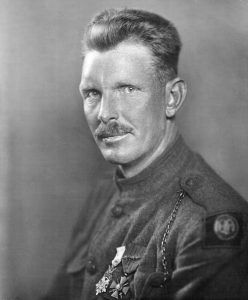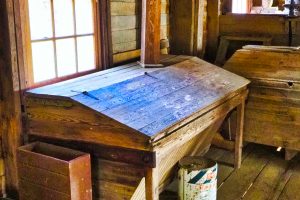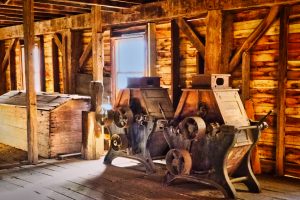We just HAD to follow the footsteps of Sgt. Alvin C. York in Pall Mall, Tennessee! We wanted to learn more and pay homage to Sgt. York-one of the most decorated American heroes of WWI.
New generations of Americans became familiar with York through a 1940s biographical Hollywood movie, starring Gary Cooper. Gary Cooper won an Oscar for best actor for his portrayal of Sgt. York. York’s military service in WWI and the movie (made much later) made Alvin York a household name. For we seniors, Sgt. York’s story has been a part of our growing up years.
So, who was Alvin C. York?

YORK’S BACKGROUND
Alvin C. York was the third oldest in a family of eleven children and was born in a 2-room log cabin in the backwoods of Pall Mall, Tennessee. He had a total of 9 months of education.
He had never traveled more than 50 miles from home prior to WWI. Alvin C. York helped support his family by hunting and farming with his prize-winning hunting skills. He became widely known and was considered an expert marksman.
As a young man, York was a gambler and heavy drinker. He attended a church only to get to know a girl. In 1914, York’s best friend was killed in a bar fight. That same year, he was converted at a revival meeting into the Church of Christ in Christian Union, a fundamentalist congregation. This church was extremely strict and forbade drinking, gambling, dancing, movies and more. The church had a following in only three states-Tennessee, Ohio and Kentucky. The church also forbade violence and war.*

YORK IN WORLD WAR I
When WWI started, York attempted to apply for conscientious-objector status. His religion was not a formally recognized sect and his conscientious-objector status was denied. At age 30, he wrote on his draft registration card, ” Don’t want to fight.”
York was assigned to company G, 328th Infantry Regiment, 82nd. Infantry Division. He struggled with the morality of going to war. His company commander, a devout Christian, had long talks with York about Biblical justifications for war. York came to believe that God meant for him to fight.
His unit relieved other units in the Meuse-Argonne Offensive in France. They received orders to take Hill 223. His unit took heavy casualties. 17 men, including York, were told to go to the rear of the Germans and take the machine guns aimed at the U.S. troops.
Beginning in a prone position, he utilized the shooting skills he had honed as a boy. Picking off the German gunners, York was able to move to a standing position as he evaded enemy fire. During the course of the fight, six German soldiers emerged from their trenches and charged at York with bayonets. Running low on rifle ammunition, he drew his pistol and dropped all six before they reached him. Switching back to his rifle, he returned to sniping at the German machine guns. Believing he had killed around 20 Germans, and not wishing to kill more than necessary, he began calling for them tor surrender.**
He captured approximately 100 Germans! Another 30 Germans were captured as York’s unit took the prisoners to the American headquarters. After the prisoners were delivered, York rejoined the unit and fought through to the Decauville Railroad. In the fight, 28 Germans were killed and 35 machine guns captured.
WHAT TO SEE
Alvin C. York was one the greatest military heroes in WWI and was awarded the Medal of Honor. As a result, York was offered lucrative endorsements, speaking deals and more. He chose to return to Pall Mall, Tennessee because he believed it was wrong to profit from war.
The Nashville Rotary Club raised funds to buy York a farm and build him a home.

Visit the Sgt. Alvin C. York State Historic Park! Sites include:
- A Visitor’s Center modeled after York’s General Store and Post Office. The Store has an exhibit with artifacts from WWI and a 15- minute video about York. York opened his general store in 1925.
- York’s two-story home. the first floor is now a museum.
- York’s Grist Mill. The Mill was constructed 1880 and was used to grind corn into cornmeal. Sgt. York purchased the gristmill in 1943 and personally ran the mill until the early 1950s.
- York Bible School was built by York in the 1940s with the profits from the 1941 film “Sergeant York.” It operated only briefly.

Just outside the State Park is:
- Wolf River Methodist Church (established in 1840) which York attended; and,
- The burial sites of Sgt. York and his wife, Gracie.
The York farm and mill were added to the U. S. National Register of Historic Places in 1973.
There are daily tours of the York home and farm. Tours begin at 9:00 a.m. and are scheduled every hour until 3:00 p.m. CT. The cost is $5 for those 13 years of age and older. The tour is free for children ages 12 and younger.
Directions:
The York house, mill and post office are on US-127. The Wolf River Cemetery, Wolf River Methodist Church and the York Bible Institute are located along Wolf River Loop, a paved road that intersects with US-127 about a mile south of the York home.
We are so happy we visited the Sgt. Alvin C. York State Park and associated sites!